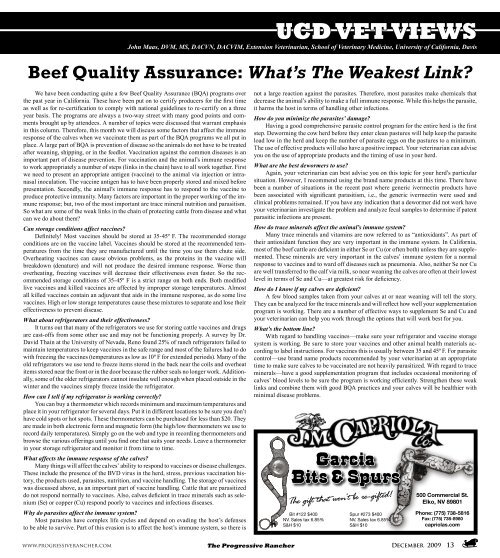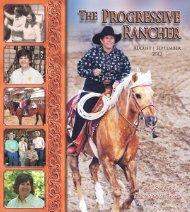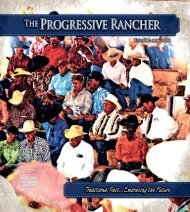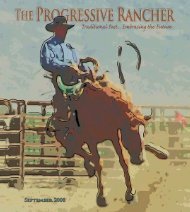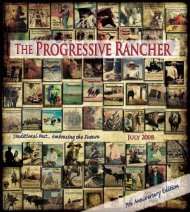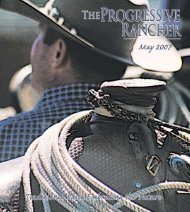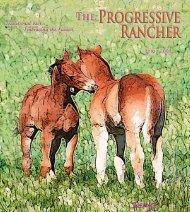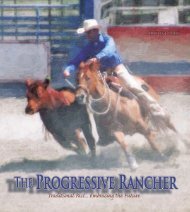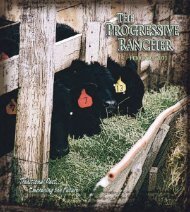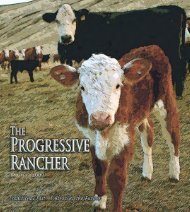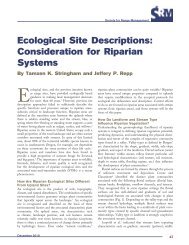The Progressive Rancher Magazine
The Progressive Rancher Magazine
The Progressive Rancher Magazine
Create successful ePaper yourself
Turn your PDF publications into a flip-book with our unique Google optimized e-Paper software.
UCD VET VIEWS<br />
John Maas, DVM, MS, DACVN, DACVIM, Extension Veterinarian, School of Veterinary Medicine, University of California, Davis<br />
Beef Quality Assurance: What’s <strong>The</strong> Weakest Link?<br />
We have been conducting quite a few Beef Quality Assurance (BQA) programs over<br />
the past year in California. <strong>The</strong>se have been put on to certify producers for the first time<br />
as well as for re-certification to comply with national guidelines to re-certify on a three<br />
year basis. <strong>The</strong> programs are always a two-way street with many good points and comments<br />
brought up by attendees. A number of topics were discussed that warrant emphasis<br />
in this column. <strong>The</strong>refore, this month we will discuss some factors that affect the immune<br />
response of the calves when we vaccinate them as part of the BQA programs we all put in<br />
place. A large part of BQA is prevention of disease so the animals do not have to be treated<br />
after weaning, shipping, or in the feedlot. Vaccination against the common diseases is an<br />
important part of disease prevention. For vaccination and the animal’s immune response<br />
to work appropriately a number of steps (links in the chain) have to all work together. First<br />
we need to present an appropriate antigen (vaccine) to the animal via injection or intranasal<br />
inoculation. <strong>The</strong> vaccine antigen has to have been properly stored and mixed before<br />
presentation. Secondly, the animal’s immune response has to respond to the vaccine to<br />
produce protective immunity. Many factors are important in the proper working of the immune<br />
response; but, two of the most important are trace mineral nutrition and parasitism.<br />
So what are some of the weak links in the chain of protecting cattle from disease and what<br />
can we do about them?<br />
Can storage conditions affect vaccines?<br />
Definitely! Most vaccines should be stored at 35-45º F. <strong>The</strong> recommended storage<br />
conditions are on the vaccine label. Vaccines should be stored at the recommended temperatures<br />
from the time they are manufactured until the time you use them chute side.<br />
Overheating vaccines can cause obvious problems, as the proteins in the vaccine will<br />
breakdown (denature) and will not produce the desired immune response. Worse than<br />
overheating, freezing vaccines will decrease their effectiveness even faster. So the recommended<br />
storage conditions of 35-45º F is a strict range on both ends. Both modified<br />
live vaccines and killed vaccines are affected by improper storage temperatures. Almost<br />
all killed vaccines contain an adjuvant that aids in the immune response, as do some live<br />
vaccines. High or low storage temperatures cause these mixtures to separate and lose their<br />
effectiveness to prevent disease.<br />
What about refrigerators and their effectiveness?<br />
It turns out that many of the refrigerators we use for storing cattle vaccines and drugs<br />
are cast-offs from some other use and may not be functioning properly. A survey by Dr.<br />
David Thain at the University of Nevada, Reno found 25% of ranch refrigerators failed to<br />
maintain temperatures to keep vaccines in the safe range and most of the failures had to do<br />
with freezing the vaccines (temperatures as low as 10º F for extended periods). Many of the<br />
old refrigerators we use tend to freeze items stored in the back near the coils and overheat<br />
items stored near the front or in the door because the rubber seals no longer work. Additionally,<br />
some of the older refrigerators cannot insulate well enough when placed outside in the<br />
winter and the vaccines simply freeze inside the refrigerator.<br />
How can I tell if my refrigerator is working correctly?<br />
You can buy a thermometer which records minimum and maximum temperatures and<br />
place it in your refrigerator for several days. Put it in different locations to be sure you don’t<br />
have cold spots or hot spots. <strong>The</strong>se thermometers can be purchased for less than $20. <strong>The</strong>y<br />
are made in both electronic form and magnetic form (the high/low thermometers we use to<br />
record daily temperatures). Simply go on the web and type in recording thermometers and<br />
browse the various offerings until you find one that suits your needs. Leave a thermometer<br />
in your storage refrigerator and monitor it from time to time.<br />
What affects the immune response of the calves?<br />
Many things will affect the calves’ ability to respond to vaccines or disease challenges.<br />
<strong>The</strong>se include the presence of the BVD virus in the herd, stress, previous vaccination history,<br />
the products used, parasites, nutrition, and vaccine handling. <strong>The</strong> storage of vaccines<br />
was discussed above, as an important part of vaccine handling. Cattle that are parasitized<br />
do not respond normally to vaccines. Also, calves deficient in trace minerals such as selenium<br />
(Se) or copper (Cu) respond poorly to vaccines and infectious diseases.<br />
Why do parasites affect the immune system?<br />
Most parasites have complex life cycles and depend on evading the host’s defenses<br />
to be able to survive. Part of this evasion is to affect the host’s immune system, so there is<br />
not a large reaction against the parasites. <strong>The</strong>refore, most parasites make chemicals that<br />
decrease the animal’s ability to make a full immune response. While this helps the parasite,<br />
it harms the host in terms of handling other infections.<br />
How do you minimize the parasites’ damage?<br />
Having a good comprehensive parasite control program for the entire herd is the first<br />
step. Deworming the cow herd before they enter clean pastures will help keep the parasite<br />
load low in the herd and keep the number of parasite eggs on the pastures to a minimum.<br />
<strong>The</strong> use of effective products will also have a positive impact. Your veterinarian can advise<br />
you on the use of appropriate products and the timing of use in your herd.<br />
What are the best dewormers to use?<br />
Again, your veterinarian can best advise you on this topic for your herd’s particular<br />
situation. However, I recommend using the brand name products at this time. <strong>The</strong>re have<br />
been a number of situations in the recent past where generic ivermectin products have<br />
been associated with significant parasitism, i.e., the generic ivermectin were used and<br />
clinical problems remained. If you have any indication that a dewormer did not work have<br />
your veterinarian investigate the problem and analyze fecal samples to determine if patent<br />
parasitic infections are present.<br />
How do trace minerals affect the animal’s immune system?<br />
Many trace minerals and vitamins are now referred to as “antioxidants”. As part of<br />
their antioxidant function they are very important in the immune system. In California,<br />
most of the beef cattle are deficient in either Se or Cu (or often both) unless they are supplemented.<br />
<strong>The</strong>se minerals are very important in the calves’ immune system for a normal<br />
response to vaccines and to ward off diseases such as pneumonia. Also, neither Se nor Cu<br />
are well transferred to the calf via milk, so near weaning the calves are often at their lowest<br />
level in terms of Se and Cu—at greatest risk for deficiency.<br />
How do I know if my calves are deficient?<br />
A few blood samples taken from your calves at or near weaning will tell the story.<br />
<strong>The</strong>y can be analyzed for the trace minerals and will reflect how well your supplementation<br />
program is working. <strong>The</strong>re are a number of effective ways to supplement Se and Cu and<br />
your veterinarian can help you work through the options that will work best for you.<br />
What’s the bottom line?<br />
With regard to handling vaccines—make sure your refrigerator and vaccine storage<br />
system is working. Be sure to store your vaccines and other animal health materials according<br />
to label instructions. For vaccines this is usually between 35 and 45º F. For parasite<br />
control—use brand name products recommended by your veterinarian at an appropriate<br />
time to make sure calves to be vaccinated are not heavily parasitized. With regard to trace<br />
minerals—have a good supplementation program that includes occasional monitoring of<br />
calves’ blood levels to be sure the program is working efficiently. Strengthen these weak<br />
links and combine them with good BQA practices and your calves will be healthier with<br />
minimal disease problems.<br />
Garcia<br />
Bits & Spurs<br />
<strong>The</strong> gift that won’t be re-gifted!<br />
Bit #122 $400<br />
NV. Sales tax 6.85%<br />
S&H $10<br />
Spur #273 $400<br />
NV. Sales tax 6.85%<br />
S&H $10<br />
500 Commercial St.<br />
Elko, NV 89801<br />
Phone: (775) 738-5816<br />
Fax: (775) 738-8980<br />
capriolas.com<br />
www.progressiverancher.com<br />
<strong>The</strong> <strong>Progressive</strong> <strong>Rancher</strong> December 2009 13


